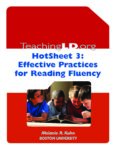Effective Practices for Reading Fluency
Fluent reading is one of the hallmarks of skilled readers, and, since the publication of the National Reading Panel report (2000), it has received considerable attention as a central component of the reading process. When reviewing the role that fluency actually plays in reading development, it quickly becomes apparent that this attention is well deserved. What may be less apparent, however, is how teachers and others who work directly with students can easily integrate effective approaches to oral reading instruction into their curricula.
In this Hot Sheet, I address fluency in connected text, rather than word lists; this distinction is critical if learners are to become fluent readers. Although reading words in lists can help develop speed in isolation, fluent reading of connected text is more important. One of the goals of reading aloud is to make the print sound like natural speech and, of course, it is much easier to make connected text sound natural than it is to make unconnected lists of words sound natural.
What is Fluent Reading and Why is it Important?
Fluent reading incorporates three primary elements: accuracy, automaticity, and prosody (Kuhn & Stahl, 2003; National Reading Panel, 2000), each of which is crucial to skilled reading. Further, by looking at these elements individually, it becomes possible to identify the role that each plays in students’ developing ability to read. To construct meaning from text, it is essential that students accurately identify the vast majority of the words they encounter in print (for example, texts are considered to be at a reader’s independent level when they are read with approximately 98% accuracy). CAUTION: Although accurate word recognition is necessary for skilled reading, it is not sufficient. In fact, if students need to expend significant amounts of effort figuring out individual words—even if they do so with a high percentage of accuracy—they are unlikely to have enough attention remaining to focus on the meaning of what they are reading. As a result, it is necessary for learners’ word recognition to become automatic, as well as accurate, in order to comprehend text (LaBerge & Samuels, 1974).
The final indicator of fluent reading is prosody (e.g., Erekson, 2003). Prosody consists of those elements that allow oral reading to sound expressive; these include the use of appropriate phrasing, the placing of stress on certain words in order to convey shades of meaning, and the changing of pitch when encountering certain types of questions.These subtle aspects of reading, sometimes—though not always—indicated through punctuation, allow students to demonstrate their ability to construct meaning from the text. Ultimately, it is the integration of these elements, along with accuracy and automaticity, into learners’ oral reading that allows them to see themselves as fluent readers.
Reading Fluency PDF
 View PDF: "Reading Fluency PDF"
View PDF: "Reading Fluency PDF" Melanie Kuhn describes the importance of reading fluency, how to measure it, and what is known about effective practices.